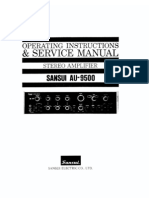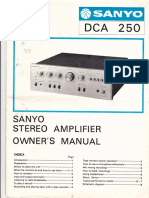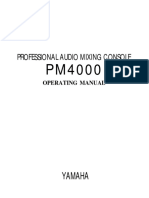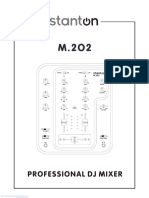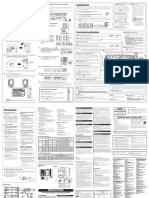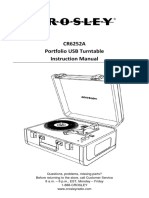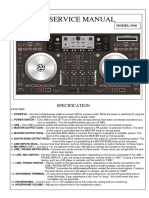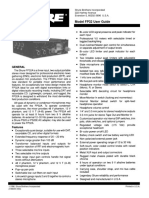0 ratings0% found this document useful (0 votes) 337 views58 pagesTascam 244 Owners Manual PDF
Copyright
© © All Rights Reserved
We take content rights seriously. If you suspect this is your content,
claim it here.
Available Formats
Download as PDF or read online on Scribd
TASCAM
TEAC Production Products
244
-PORTASTUDIO
Ss
( OWNER’S MANUAL _�TABLE OF CONTENTS
INTRODUCTION TO THE MANUAL,
AND HOW TO USE IT 3-4
THE dB; WHO, WHAT, WHY 6-9
IMPEDANCE MATCHING
AND LINE LEVELS 10-14
REFERENCE LEVELS 12-13
HOW AMPLIFIERS WORK 13-14
WARNINGS AND CAUTIONS 15-17
UNDERSTANDING THE WIRING SEQUENCE
AND THE BLOCK DIAGRAM 16—17
PORTASTUDIO PARTS LIST; WHERE THEY
ARE AND HOW THEY WORK .... 18—35
1, MIC/LINE INPUT Connector 18
2. TRIM Control 18-19
3. OVERLOAD LED. 19
4, INPUT Select Switch 19—20
5, ACCESSORY-SEND-RCV RCA
Jacks 20—21
6.PRE-FADER SELECT for “AUX’ 21
7. Two Section Semi-Parametric (Sweep)
EQualizer 2122
8 Input Fader 22-23
9. AUX System Select Switch 23
10. AUX System Duat Concentric
Controls 23
A. AUX-GAIN (upper section}
8. AUX-PAN (lower section)
11. Aux Send Summing Amps 23-24
12, AUX-SEND RCA Jacks 24
13. AUX-RCV IN RCA Jacks 24—26
14, AUX-RCV Dual Control 24—26
15. Input Module Buffer Amp 26-27
16. Input Module PAN Control 27
17.L+R Buss Summing Amps 27
18.L+R MASTER Fader 27
19. L+R MASTER Fader Isolation
Amp 27
20.L+R MASTER LED Amps and
LED OVERLOAD Indicators 27
CORRECT METHOD OF LEVEL SETTING
FOR THE PORTASTUDIO 28—29
21,L+R LINE OUT 29
@ dbx noise reduction system made under lik
cense from dbx, incorporated. The name “dbx”
‘and the dbx symbol are trademarks of dbx,
locorporated.
© Change in specifications and features may be
made without notice or obligation
WARNING: TO PREVENT FIRE OR SHOCK
HAZARD, 00 NOT EXPOSE THIS APPLIANCE
TO RAIN OR MOISTURE
22.L+R AUX OUT 29,
23. MONITOR (Headphone) Switch and
its Logic 30-31
2. BUSS MONITOR Level Control 31
RECORD FUNCTION SELECT SWITCHES
AND THEIR LOGIC 31-33
25. RECORD FUNCTION Switch. 31-32
26. 4CH REC LED 32
27. Upper BUSS Assign Switch,
BUSS L 32
28. Lower BUSS Assign Switch,
BUSS R 32
TAPE TRANSPORT SECTION 34—35,
RECORDING THE FIRST TRACK . 36—39
FIRST PLAYBACK, 33
THE OVERDUB 40-48
FANCY CUEING 42—45
29, TAPE CUE-PAN 1-4 42
30, TAPE CUE-GAIN 1-4 42
31. L and R TAPE CUE OUT RCA.
Jacks a2
32. Dual Tip-Ring-Sleeve HEADPHONE Amp
Output 44
HOW TO MAKE A “PING PONG’
(COLLAPSE, ALSO CALLED “BOUNCING
TRACKS”) 46
FOUR CHANNEL RECORD SPECIA
FUNCTION AND THE METER 4 CHANNEL
RECORD LOGIC 47—48
REMIX 49—50
CARE AND MAINTENANCE 51-52
CLEANING 81
DEGAUSSING (DEMAGNETIZING)
51-52
Voltage Conversion 52
Note for U.K, Customers 52
SPECIFICATIONS 63
BLOCK DIAGRAM 54—55
HOW THE DBX WORKS 56
LEVEL DIAGRAM. 57
This apparatus has a serial number located
on the rear panel. Please record "e model
number and serial number and rejain them
tor your records.
Model number
Serial number�INTRODUCTION TO THE MANUAL, AND HOW TO USE IT
The Model 244 PORTASTUDIO combines all the
major components of the modern multitrack re-
cording stidio into one compact and portable
unit. Even though it is small, it represents an
enormous «mount of high technology,
Basic Trac. Recording, Overdubbing in “Sync”
and Remixing of 4 channels to mono or stereo
can be accomplished with @ minimum of extra
equipment Far example, a songwriter working
alone with the PORTASTUDIO would need only
a mic, a iilic cable and a headset to produce a
complex d:monstration tape. Of course, the in-
struments to make the music, skill in playing
and a sont) to record are also necessary, $0 our
large amount of technology can only be of use
to the artist as a part of the ontire creative
process, Tlie 244 PORTASTUDIO and its techno-
logy can enter the picture onty after much hard
work has slready taken place.
At TASCAM, we recognize the fact that multi
channel renording is never completely a scienti-
fic process It is always @ combination of many
disciplines, and the products that we design and
build provide only the potential for good results,
ot @ guat antee.
When you ourchase the PORTASTUDIO, we can
supply you with the Technology, but in order to
exploit it > the service of your Art you must
expect to spend some time in learning what
nob to tu’ and what switch to set for each
function yau require. You can help yourself by
reading this Owner's Reference Manval slowly
ang carefvily.
This manual presumes nothing about your past
experience with the multichannel process except
a willingness to learn. An expert in the field
might see the significance of a control or jack
with just «| simple statement of its location, but
in this manual we will point out “the obvious”
many times just to make sure that you see the
point. Thee is much to discuss, and we have
tried to moke these instructions as SIMPLE AS
THE TECHNOLOGY WILL ALLOW.
The Logic Used in the Manual
In prepari'ig this Manual, wo started by asking
ourselves (nese questions:
What Does the First Time User Want to Do?
Begin recc-ding as soon as possible. In order to
do this, tlie basic connections must be made,
some addilional equipment must be plugged in
correctly, and some decisions about function
must be fade. You must deal with the techno-
fogy, or th unit will do nothing usetul.
What Should We Tell the First Time User About
the PORTASTUDIO When We Begin?
Even an expert engineer will need some instruc-
tion at this point, so we must make decisions
about the format of our manual. Rather than
having separate sections, one with 2 great deal
of complex analysis and another with 2 simplis-
tic approach, we have decided to combine the
two styles in one continuous job-related fashion.
Why? Consider these things:
First, this manual may be the only “experience
that you can draw upon. We have said that we
wil explain the benefit of each control as well
as “he way to “turn” or set it, and the science
behind its function. If you have little or no prac~
tical experience, you will not easily find the ad-
vice you need unless we place it in a sequence
that does not depend on prior knowledge of the
process
Second, the terms that we use in the index may
not relate the use of the PORTASTUDIO or to
the field that you already know. For example, a
musician will call the beginning of the tape the
top", because it relates to the top of @ piece of
musi¢ paper. An audio-visual producer would
refer to the beginning of the program as “home”
as in “return home” when thinking of the re
wind function. This variation in the “jargon”
makes the use of @ conventional Index or Table
of Contents difficult, and you have no guarantee
of finding the help you need easily. Our job relat-
ed sequence of instruction is self indexing to a
much larger extent. It is laid our this way:
1. COMPLETE ANALYSIS: The manual begins at
the MIC/LINE INPUT connector on the mixer
section back panel and goes through each
circuit in the order in which they are wired,
BUT THERE IS ALSO.
2. A SIMPLE ILLUSTRATED GUIDE: The complex
text is augmented with 2 group of large illus-
trations that have sufficient caption material
to allow you to work more rapidly. If you have
no troubles in following the “short form” in-
structions in the first large illustration, you
can flip the pages to the next large drawing
and continue the process. If you require more
explanation of a circuit, simply read the “fine
print” on the pages that come before and
after the drawing that shows the function you.
are having trouble with
The major topic groups in the manual are “job
related” to the multitrack recording process and
appear in this order







